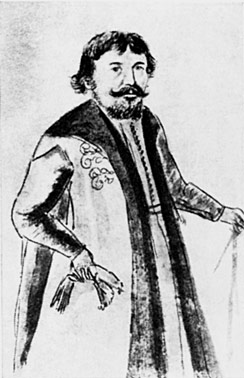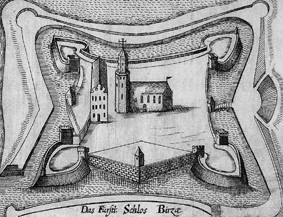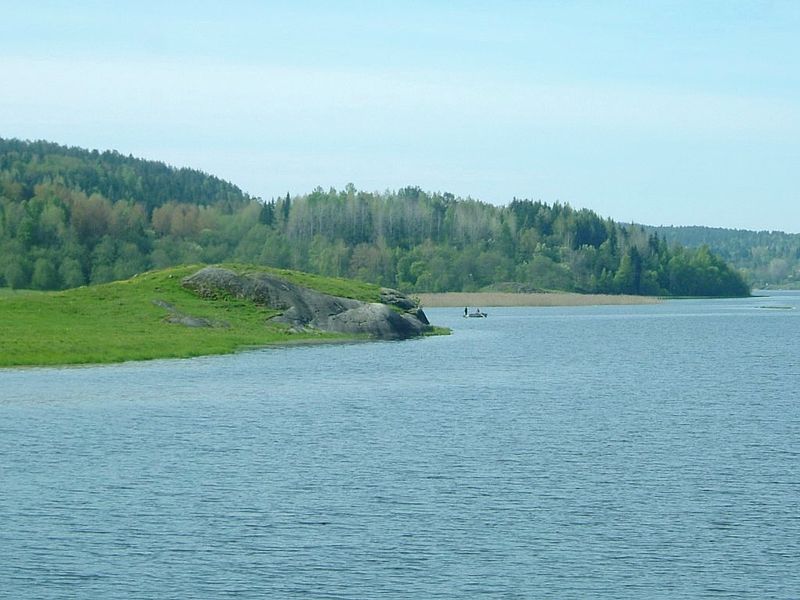| Narva Castle |
Peter was
stunned by the news of the loss at Narva. Two weeks after the battle he wrote
to Sheremetev
‘We must not lose our heads
in misfortune. I order the work we have undertaken to go on. We do not lack
men; the rivers and marshes are frozen. I will hear no excuses.’[i]
The beaten
army straggled into Novgorod and Peter used troops who had not been mustered in
time and the re-organised survivors of Narva, plus 10,000 Cossacks, to form a
new army of 44,000 men. Peter also ordered Prince Boris Galitzyne to raise ten
new regiments of 1,000 men each. Command of this new army was given to Boris
Sheremetev.
Peter
ordered the construction of fortifications at Novgorod, Pskov and the Pescherk
monastery near the town; Peter himself laboured on the Novgorod fortifications.
Even with the new army raised Peter realised that proper training was required
and a permanent professional army would be needed for his dreams of expansion.
Self portrait - Andrew Vinius
Andrew Vinius, the director of the Post Office,
was required to re-equip the new army with artillery; he was given the new
title of Inspector of Artillery. Given the losses before Narva, Vinius had to
start from scratch. With no time to mine and refine metals Peter ordered
‘From the whole of Tsardom,
in leading towns, from churches and monasteries, a proportion of the bells are
to be collected for guns and mortars.’[ii]
By June 1701
a quarter of all church bells in Russia had been melted down and recast as
cannon. Despite problems with foundry workers, Vinius had twenty cannon
delivered to Novgorod, with a further seventy-six following shortly thereafter.
Augustus of Poland
Looking for
assistance to mediate with Sweden, Peter sent ambassadors abroad; but the
rulers of Europe were too engrossed in what was to become known as the War of the Spanish Succession. Peter now turned to his, by now
very nervous, ally Augustus. In ten days of meetings the two renewed their
alliance.
‘The King of Poland had
engaged to furnish the Czar with fifty thousand German troops, which they were
to hire of several Princes, and the Czar was to pay for. And he on the other
hand was to send fifty thousand Moscovites, into Poland, to be trained up in
discipline.’[iii]
What Charles Did Next
Charles XII of Sweden
Charles XII
now thought seriously about invading Russia; buoyed up by his own victories in
Zealand and at Narva, he was beginning to ignore advice. In December an officer
of the King’s Guards wrote
‘I believe that if he
[Charles] had only eight hundred men left, he would invade Russia with them,
without the slightest thought as to what they would live on. And if one of our
men is shot, he cares no more about it than he would for a louse.’[iv]
16th century Livonia
The Swedish
army was suffering from hunger and disease; Peter’s soldiers had already
plundered Livonia for food and supplies from Sweden could not arrive until the
Baltic thawed. The cavalry horses were eating bark from the trees.
Charles
finally agreed to go into winter quarters, but by the spring his contempt for
the Russian military had increased. He thought that another victory over the
Russians would not be appreciated by the courts of Europe as much as a victory
over Augustus’s disciplined Saxon troops. In any event an attack into Russia
could not be considered while Saxon armies ranged freely in his rear.
‘It was in this place [Birzen[v]]
that he laid the design of dethroning the King of Poland by the hands of the
Poles themselves.’[vi]
Charles was
refused permission to enter Poland in pursuit of the Saxon army. The Catholic Primate
of Poland insisted that Augustus had made war on Sweden in his role as Elector
of Saxony and without the consent of the Polish nobility. Charles replied that
in that case Augustus had forfeited the crown of Poland and that the nobility
should dethrone Augustus. The answer to Charles letter took some moths to come
but when it did it transpired that the Poles were not prepared to do Charles’
dirty work for him.
In the
spring of 1702 Charles invaded Poland and on 9th July defeated
Augustus near Klissow.
‘The two Kings met….in a
large plain near Clissau between Warsaw and Cracow. Augustus had near four and
twenty thousand men, and Charles XII not above twelve thousand.’[vii]
The battle
was inconclusive as the majority of Augustus’s army escaped yet again. The time
spent by Charles on the campaign in Poland had given Peter a breathing space, in
which the army gained some morale boosting small victories.
On Land and Sea
Sheremetev
attacked the mobile Swedish force left in Livonia in January; the Russians
defeated the Swedes and Sheremetev was promoted to Field Marshall. In July
Sheremetev attacked this mobile force[viii] again and was again
victorious[ix]; the self-confidence of
his men grew. The result of the battle at Hummelshof meant that there was no
mobile Swedish force in Livonia, only the static troops guarding Riga, Pernau
and Dorpat
Lake Ladoga
Peter decided
that to attack the Swedish naval control of the Baltic he would require large
numbers of smaller more manoeuvrable ships. On 20th June 1702 a
little of flotilla of 18 Russian boats on Lake Ladoga caught a
Swedish squadron anchored and attacking a village. The flagship was damaged and
the Swedes retreated. The same squadron was attacked again on September 7th
by thirty Russian boats and this time the squadron sailed out of Lake Ladoga.
The withdrawal of all the Swedish ships from the Ladoga, down the Neva, gave the
Russians unchallenged passage across the lake.
Narva River basin
The same
tactics were taken on Lake
Peipus, south of Narva, and again ended with the Swedes withdrawing their
ships to safer waters. They returned in strength to reclaim the lake in 1703
but the tables were irreversibly turned in 1704. The Swedish flotilla was
caught up river at Dorpat[x]. The Russians threw a boom
across the mouth of the river and brought up artillery. Beyond the boom 200
Russian ships waited. The current pulled the hapless Swedish ships onto the
boom where they were blown to pieces by the artillery.
Matveyev
received information that the Swedes were intending to attack Archangel,
Russia’s only port. Peter and Czarevitch
Alexei set out in April 1702, accompanied by 4,000 men. On his arrival the
defences were put in good order and the Russians waited for the Swedish attack.
In August the annual Anglo-Dutch merchant fleet sailed into port with the news
that the Swedes had dismissed ideas of attacking Archangel.
St Petersburg
Noteberg
Peter
immediately took his guard and ordered Sheremetev and Peter Apraxin[xi], who had been harassing
the Swedes in Ingria, to join him in capturing the Swedish fortress of Noteberg[xii]. Within ten days of the
artillery assault the fortress surrendered.
‘In truth, this nut was very
hard, but, thank God, it has been happily cracked. Our artillery did its work
magnificently.’[xiii]
As an
ecstatic Peter wrote to Vinius[xiv]. He renamed the fortress
Schlüsselburg and made Alexander Menshikov[xv] the governor.
In the
spring of 1703, determined to expand Russian influence in the Baltic, Peter had
an army of 20,000 men, under Sheremetev, march down from Noteberg to the
Baltic. Peter followed with a flotilla of sixty ships from Lake Ladoga.
On 11th
May, after being subject to a barrage of artillery fire, the small Swedish
settlement of Nyenskans surrendered. Two vessels from a Swedish fleet in the
gulf were captured in a river battle on 18th May, after their
detachment to ascertain the safety of Nyenskans.
Peter
decided to build a fortress to guard the mouth of the Neva, the fort’s first
sod was turned on 16th May and by October the construction was well
underway. The fort was necessary as Peter was aware that the Swedes could not
allow the Russians access to the Baltic, from whence they could challenge the
Swedish mastery of the sea.
In the
summer of 1703 a Swedish army of 4,000, camping on the north side of the Neva,
was defeated by Peter’s men. On 7th July Peter personally led his
soldiers and the defeated Swedes retreated. Throughout the summer the Swedes
kept nine ships on standby at the mouth of the Neva, blocking Russian access to
the Baltic.
Towards the
end of the year the cold weather forced the withdrawal of the Swedish ships and
Peter took his first trip on the Baltic in a Russian ship. He noted a small
island at the mouth of the Neva and immediately ordered the building of a fort.
By spring a small fort protected a channel from the Neva and the building work
proceeding on the island.
Peter intended
that his new settlement would also be a port and encouraged ships from western
Europe to sail to St Petersburg to trade. To strengthen his grip on his new
foothold Peter ordered more ships from the Lake Ladoga shipyard. Peter wrote to
Menshikov on 23rd September 1704.
‘Here, thanks be to God, all
goes fairly well. Tomorrow and the day after, three frigates, four snows, a
packet-boat and a galliot will be launched.’[xvi]
To avoid the
treacherous waters of Lake Ladoga Peter decided to move the main shipyard to St
Petersburg.
The Swedes
returned to attack the new settlement regularly and were driven off each time.
Peter’s ambitions for St Petersburg gradually expanded and in early 1703 an
Italian architect arrived in Russia, Domenico Trezzini, heavily influenced by Dutch northern baroque. On the
1sr April he signed a contract to become the Czar’s Master of Building,
Construction and Fortification.
For nine
years Trezzini directed the building of the city, which entailed a huge cost in
human lives, estimates range from 25,000 to 100,000 workers losing their lives
to scurvy, dysentery malaria and other assorted diseases. Workplace conditions
were appalling; the ground was marshy and all materials had to be imported;
every vessel, carriage and cart had to bring a quota of stone or rock before
being allowed entrance to St Petersburg. In 1713 Trezzini began the building of
the St Peter and St Paul Cathedral.
St Peter and St Paul Cathedral
To populate
his city Peter invited his sister and
half-sisters, the Czarevnas, the dowager Czaritas and hundreds of noblemen,
officials and wealthy merchants. No-one was allowed to excuse themselves;
traders and shopkeepers followed, lured by the exorbitant prices they could
charge for goods.
Many of the
labourers stayed, unable to walk the long distance home and were used the build
the homes of the private citizens. The style of building and materials were
laid down by decree. Many of the buildings were made of wood and fire was a
constant danger, as was flooding in the winter.
Bibliography
Natasha’s
Dance – Orlando Figes, Penguin Books Ltd 2002
Russia and
the Russians – Geoffrey Hosking, The Penguin Press 2001
Peter the
Great – Robert K Massie, Abacus 1992
The History
of Charles XII of Sweden – Mr de Voltaire, C Davis & A Lyon 1732
www.wikipedia.en
[i]
Peter the Great - Massie
[ii]
Ibid
[iii]
The History of Charles XII - Voltaire
[iv]
Peter the Great - Massie
[v]
In northern Lithuania
[vi]
The History of Charles XII - Voltaire
[vii]
Ibid
[viii]
Now severely depleted
[ix]
Among the prisoners was the woman who would eventually become Peter’s second
wife
[x]
Now know as Tartu
[xi]
Brother of Admiral Feodor Apraxin, brother-in-law of Peter’s half-brother
Feodor III
[xii]
Standing at the point where Lake Ladoga empties into the Neva River,
controlling all trade passing into Russia; now called Shlisselberg
[xiii]
Peter the Great - Massie
[xiv]
Inspector of Artillery and an old friend from the German Suburb
[xv]
One of Peter’s major confidants
[xvi]
Peter the Great - Massie

.jpg/400px-A%C5%ADgust_Mocny._%D0%90%D1%9E%D0%B3%D1%83%D1%81%D1%82_%D0%9C%D0%BE%D1%86%D0%BD%D1%8B_(H._Rodakowski,_XIX).jpg)

.png)





No comments:
Post a Comment
Note: only a member of this blog may post a comment.